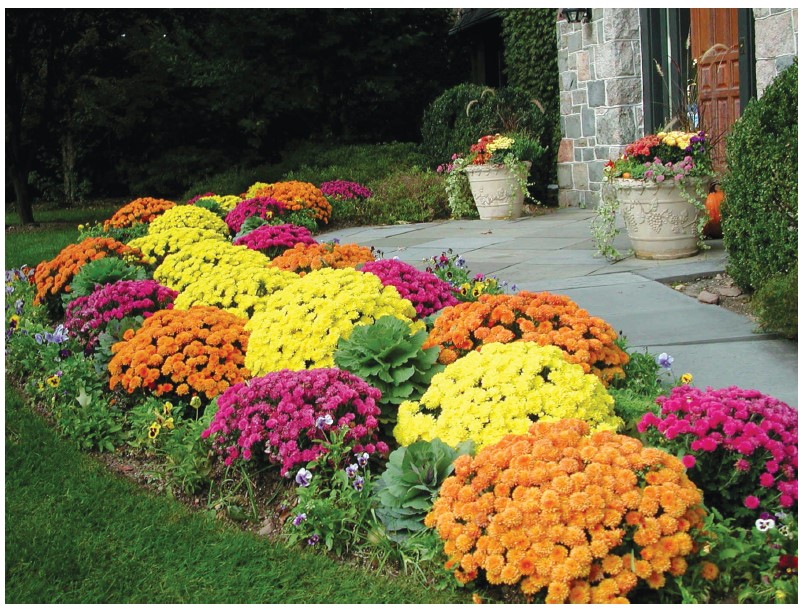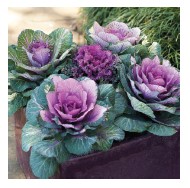The Chrysanthemum symbolizes fidelity, optimism, joy and long life. Red for love, white for truth and loyal love, and yellow for slighted love.
At one point, it felt like summer was going to last forever. The extreme heat of August and September made it difficult for local gardeners to get motivated, but finally in the first week of October, thoughts turned to the garden and the tasks awaiting there. Although the island may have very warm temperatures well into the fall months, there is still much excitement as the garden centers begin to feature the latest in annuals, perennials, and bulbs.
When thinking of fall blooms, we often begin with chrysanthemums, the flower of November. Chrysanthemums were first cultivated in China as a flowering herb in the 15th century BC and then in Japan around the 8th century AD. The Emperor of Japan became so enamored of the chrysanthemum that he adopted it as his official seal, and a Festival of Happiness is still held there in celebration of the plant.
Chrysanthemums have a wealth of meaning associated with them including fidelity, optimism, joy, and long life. The red chrysanthemum conveys love while a white one symbolizes truth. Chrysanthemum flowers bloom in various forms: daisy-like, pom poms, or button-shaped, and the blooms encompass a wide range of colors including white, purple, yellow, orange, and red.
There are two basic groups of Chrysanthemums, garden hardy and an exhibition type. Garden hardy mums are perennials capable of being wintered over in the ground in most areas; exhibition varieties are not as sturdy.
Garden hardies are defined by their ability to produce an abundance of small blooms without staking and the capacity to withstand wind and rain. Exhibition varieties often require staking and over-wintering in a cool, dry environment.
Plant chrysanthemums in full sun in well-draining soil that has been enriched with compost and do not overcrowd. Good air circulation reduces the chance of disease.
Chrysanthemums bloom in response to the photoperiodic action of shorter days and longer nights, thus be aware that planting near artificial light such as street lights may interfere with this cycle. Faded blooms should be removed regularly to help prolong flowering.
FAST FACTS ABOUT CHRYSANTHEMUMS
- Chrysanthemums are one of the most popular flowers in the world, second only to the Rose.
- Australians traditionally give their mothers chrysanthemums on Mother's Day.
- The chrysanthemum is the official flower of Chicago.
- The Supreme Order of the Chrysanthemum is a Japanese honor awarded by the Emperor.
- Chrysanthemum plants have been shown to reduce indoor air pollution by the NASA Clean Air Study.
- In Chinese cuisine, the yellow or white chrysanthemum flowers are boiled to make tea while the leaves are steamed or boiled and used as greens.
- The flowers when pulverized can be used as a natural source of the insecticide, pyrethrum.

FALL IN THE ISLAND GARDEN
Autumn is a favorite gardening period when many plants undergo a resurgence of growth and bloom. While enjoying the recovery from the nearly stifling temperatures of the summer months, gardeners can perform housekeeping duties of the garden that prepare for the introduction of the annuals of fall.
Weed and clean your beds and pots of decaying plant matter. Cut back overgrown foliage and deadhead plants with dried-up blooms to make them more attractive. A little trimming will also encourage new growth in your summer annuals.
Develop a plan. Decide where you want your new plants, then prepare your flowerbeds with the addition of compost thoroughly mixed into the existing soil. Add mulch to clay soil and humus or peat moss to sandy soil to increase the water holding capacity and drainage.
After the beds are prepared and organized, then comes the most enjoyable part of fall gardening—a trip to the garden center. Choose high-quality, healthy plants with dark green foliage and signs of bud development. Avoid tall, leggy plants. Choose those that are smaller and more compact as they will develop better root systems to sustain vigorous new growth.
Cool season plants will perform best in well-drained areas that receive ample sun. More sun generally leads to more blooms and hardier plants.

OTHER FALL FAVORITES
Asters
Dianthus
Gaillardia (blanket flower)
Ruellia (Mexican heather)
Autumn Sage
Flowering Cabbage
Larkspur Johnny Jump Ups
Snapdragons